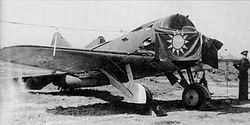Soviet Volunteer Group

The Soviet Volunteer Group was the ostensibly volunteer part of the Soviet Air Forces sent to support the Republic of China during the Second Sino-Japanese War between 1937 and 1941. After the Marco Polo Bridge Incident, the Sino-Soviet Non-Aggression Pact was signed and large Soviet support was given to China by the Soviet Union, including the volunteer squadrons. China paid for the support in the form of raw materials.
Creation and withdrawal
In October 1937, some 450 Soviet pilots and technicians assembled at Alma Ata in the USSR to bring 155 fighter aircraft, 62 bombers, and 8 trainers into China. By 1941, the Soviet-built aircraft sent to China would amount to 885, including two-engine and four-engine bombers, though the latter were never used in combat.[1] Of the aircraft supplied, half were turned over to the Chinese Air Force and half were flown and maintained by personnel from the USSR. The Soviet air units were stationed at bases near the cities of Nanjing, Hankou, and Chongqing, and at Lanzhou in China's northwest at the terminus of the Russian supply route. The Russian commander is identified in most histories as a General Asanov.[2] By the time of their withdrawal, the group's casualties amounted to 227 pilots killed in action.[3]
The Soviet squadrons were withdrawn after the Non-aggression pact between the Soviet Union and Japan in 1941. As a result, the Chinese turned to the United States, which authorized the creation of the American Volunteer Group Flying Tigers.[4]
Monuments

There are several monuments to the Soviet aviators in China, including one in Jiefang Gongyuan (Liberation Park) in Wuhan, which was built in 1956.
See also
Notes
- ↑ Wagner, p.23
- ↑ Erickson, p.491
- ↑ http://www.soldat.ru/doc/casualties/book/chapter4_4.html
- ↑ Ford, p.28
Bibliography
- Erickson, John (2001). The Soviet High Command: A Military-Political History, 1918–1941 (3rd ed.). London: Routledge. ISBN 0-7146-5178-8.
- Ford, Daniel (2007). Flying Tigers: Claire Chennault and His American Volunteers, 1941–1942. HarperCollins-Smithsonian Books. ISBN 0-06-124655-7.
- Wagner, Ray (1991). Prelude to Pearl Harbor: The Air War in China, 1937–1941. San Diego Aerospace Museum. OCLC 28440168.